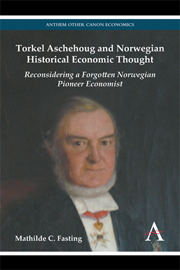 Torkel Aschehoug and Norwegian Historical Economic Thought
Torkel Aschehoug and Norwegian Historical Economic Thought Book contents
- Frontmatter
- Contents
- Acknowledgements
- Chapter 1 Introduction
- Chapter 2 Biography
- Chapter 3 Norwegian Economic and Political Context in the Nineteenth Century
- Chapter 4 Norwegian Economic Thought and Method
- Chapter 5 Development of the Economic Thought of Aschehoug: Statsøkonomisk Forening and the Socialøkonomik Project
- Chapter 6 The German Historical School: Similarities, Influences and Discrepancies
- Chapter 7 Alfred Marshall: Aschehoug and the Adoption of Marginal Theory
- Chapter 8 The French Influence: Adopting Say and Refuting Socialism
- Chapter 9 Views of Labour in the Work of Aschehoug
- Chapter 10 The Entrepreneur: The Fourth Production Factor
- Chapter 11 Trade and Customs Debates from 1840 to 1906
- Chapter 12 The Theory of Economic Crises
- Chapter 13 The Legacy of Aschehoug: Concluding Remarks
- Appendix A Other Norwegian Turn-of-the-Century Economists
- Appendix B Drafts for Socialøkonomik
- Appendix C Detailed Contents of Socialøkonomik (First Editions from 1903 to 1908)
- Notes
- Literature
- Index
Chapter 12 - The Theory of Economic Crises
Published online by Cambridge University Press: 05 March 2014
- Frontmatter
- Contents
- Acknowledgements
- Chapter 1 Introduction
- Chapter 2 Biography
- Chapter 3 Norwegian Economic and Political Context in the Nineteenth Century
- Chapter 4 Norwegian Economic Thought and Method
- Chapter 5 Development of the Economic Thought of Aschehoug: Statsøkonomisk Forening and the Socialøkonomik Project
- Chapter 6 The German Historical School: Similarities, Influences and Discrepancies
- Chapter 7 Alfred Marshall: Aschehoug and the Adoption of Marginal Theory
- Chapter 8 The French Influence: Adopting Say and Refuting Socialism
- Chapter 9 Views of Labour in the Work of Aschehoug
- Chapter 10 The Entrepreneur: The Fourth Production Factor
- Chapter 11 Trade and Customs Debates from 1840 to 1906
- Chapter 12 The Theory of Economic Crises
- Chapter 13 The Legacy of Aschehoug: Concluding Remarks
- Appendix A Other Norwegian Turn-of-the-Century Economists
- Appendix B Drafts for Socialøkonomik
- Appendix C Detailed Contents of Socialøkonomik (First Editions from 1903 to 1908)
- Notes
- Literature
- Index
Summary
Economic crisis theory is topic of interest that has been extensively discussed among economists in recent times, and many theories have been launched in order to explain economic crises. This chapter will look at what Aschehoug has to say about them and their origins (for example, chapter 94, ‘Changing good and bad times; the history of economic crises’, and chapter 95, ‘The theory of crises’). Aschehoug had, in 1898, published an article in Statsøkonomisk Tidsskrift called ‘De økonomiske kriser og depressioner i det 19de aarhundrede’, containing much of the same theory and history that is later used in Socialøkonomik, which was written almost ten years later. The historical parts are updated to include the crises at the beginning of the twentieth century, and his proposed measures and explanations are developed further.
Crises: Necessary to Analyse
The theory of crises was also the focus of another Norwegian economist and jurist, Einarsen, in the article ‘Gode og daarlige Tider’ (Good and bad times) in Statsøkonomisk Tidsskrift in 1904. Together with Aschehoug, this comprises the turn-of-the-century Norwegian literature on the subject. This article included the same theories that Aschehoug later included in Socialøkonomik.
The theory of crises is discussed in Part X of Socialøkonomik, ‘The uneven development of economic activities and results and measures against it’. This part also contains chapters about the distribution of economic wealth, the labour unions and ‘social questions’.
- Type
- Chapter
- Information
- Torkel Aschehoug and Norwegian Historical Economic ThoughtReconsidering a Forgotten Norwegian Pioneer Economist, pp. 177 - 184Publisher: Anthem PressPrint publication year: 2013
